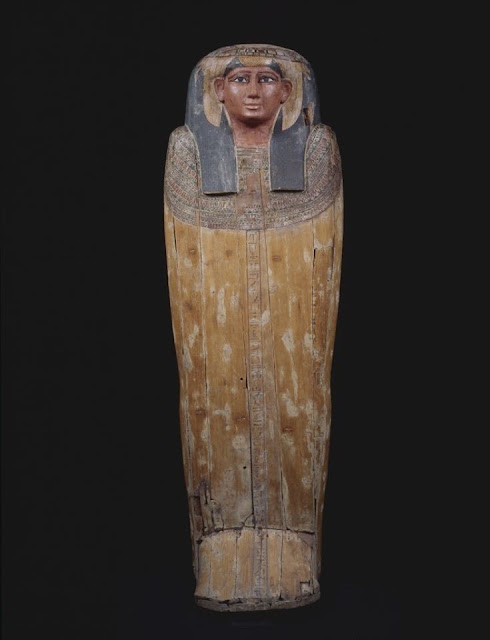This outer coffin lid is part of a lovely nested set of coffins belonged to a woman named Iawttayesheret, also call Tayesheret. The daughter of Padikhnum and Tadiaset, Iawttayesheret was the great follower of the Divine Adoratrice of Amun, and almost certainly resided in Thebes. Both her titles and the high quality of her coffins indicate that Iawttayesheret was a woman of some stature.
The Nubian kings of the Twenty-fifth Dynasty reunited Egypt following the political upheaval of the Third Intermediate Period. In order to reinforce their rule, they installed female members of the royal family in the office of the Divine Adoratrice of Amun, the highest position in the temple of the national deity. These women enjoyed unprecedented power and independence and surrounded themselves with men and women of stature and wealth. Iawttayesheret, the owner of this coffin, belonged to this elite group as one of the leaders of the retinue of the Divine Adoratrice.
In addition to restoring political order to Egypt, the Nubian kings instigated an artistic renaissance, evoking, in particular, the legacy of the Old Kingdom. Many members of the Theban aristocracy built enormous, skillfully decorated tombs around the temple of Hatshepsut at Deir el-Bahri, often containing scenes taken directly from earlier sources. Coffins for high-status burials during this period displayed a rather more austere style than those of the preceding Third Intermediate Period and adopted sculptural features such as a wide back pillar and pedestal. Nested sets of coffins continued to be used, although the outer case was typical of rectangular form, with a vaulted lid and posts at each corner.
The massive outer coffin is made of long planks with minimal embellishment, in order to highlight the surface of the wood. The wig, the floral broad collar, and a single column of text comprise the only decoration. As on the inner coffin, the wig is surmounted by a vulture headdress and fillet. A solar disk between a pair of crowned uraei appears on the crown of the head. The inscription records the name, titles, and filiation of the deceased. On the base of the coffin, there is no decoration other than a line of text around the circumference. In several places, mud plaster was applied to mask knots in the wood or joins between boards. The spare, elegant figure of the goddess of the west assumes her customary place on the bottom of the case.
It seems that Iawttayesheret owned a three-part nested set of coffins. In addition to the two cases at the Carlos, fragments of her outer coffin have been located at the Medelhausmuseet in Stockholm. The fragments are from the corner post of the outermost coffin, indicating that it was of the vaulted, rectangular variety popular during the Twenty-fifth Dynasty.



